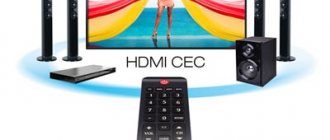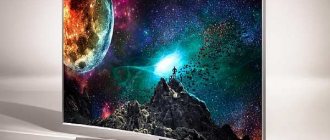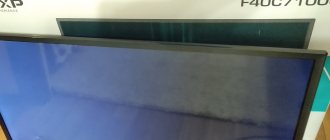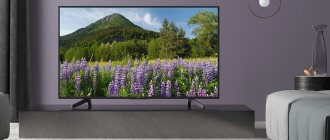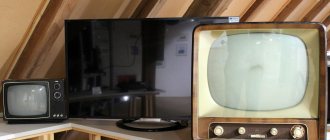In Russia, the very name “projection TV” is not very common, not to mention the device itself. Although this technology was used in the middle of the last century. It was used in television receivers, in which the image was broadcast using cathode ray tubes. This review will tell you how this technique works and what types of it are presented on the modern market.
History of projection televisions
Over the entire period of its existence, the technology has passed through the peak of popularity to its almost complete extinction. The very first TVs with projectors had a lot of disadvantages:
- poor viewing angle;
- low quality screen backlight;
- Not a good level of contrast and brightness.
Therefore, it is not surprising that with the advent of modern LED TVs, projection models almost completely ceased to be in demand.
Soviet projection TV
However, with the advent of high-definition HDTV channels, the need arose to display high-quality images on widescreen TVs. Projection models have begun to gain popularity again. The technology used to create them has become most popular in TVs with a diagonal of 50 inches or more. As it turns out, high-quality images have become cost-effective on projection TVs.
In Western Europe, Japan and the USA, the real popularity of new technologies came at the end of the 2000s, when there was a boom in the purchase of projection TVs. Gradually, cheaper flat-panel LCD and plasma TVs entered the electronics market, and large projection models quickly began to lose their popularity.
Since Russia is somewhat behind progressive countries in the field of high-definition television technologies, it is impossible to find projection televisions on official sale. However, some connoisseurs of modern and unusual devices order them through online stores.
DLP
This technology produces very high quality images without pixel structure or other imperfections. The essence of the method is to use a micromirror card as a source. The beam enters it through a system of light filters, is reflected and hits a transmitting screen.
Thus, the formation and conversion of the signal occurs using optics, and the image is bright.
Disadvantages include the appearance of a rainbow effect, when a bright spot moves quickly against a dark background or when the point of view suddenly changes.
Features of projection TV
Image formation is based on the design features of projection devices: they contain special small projectors . They direct the image to the screen through a complex system of lenses and mirrors. In general terms, it looks like the video is being projected from a TV.
The main difference between projection models and standard TVs is that the video on them has very high brightness. And thanks to special optics, the image will not be blurry, regardless of resolution.
It is very easy to distinguish projection TVs from modern models - they are more similar to old devices, their thickness can reach 40 cm. This is due to the fact that there are a lot of different parts in the design of the equipment.
Samsung SP-70L7
Liquid crystal model with good color rendering. You can connect headphones to the device; a corresponding port is provided for this. The average price is about 50 thousand rubles.
Professionals: — the screen is backed with an oil film, which makes the image clear and bright; - high pixel resolution of the matrix.
Significant disadvantages include the lack of standard cable connectors.
Projection TV design
There are devices with front and rear projection (it should be noted that the production of the latter has been discontinued since 2014). The picture will begin to “emerge” in a small source using CRT tubes or an LCD display. Then, through a system of optical lenses, it is transmitted to the screen.
The device includes the following parts:
- projector with optical system;
- boards responsible for creating the original image;
- backlight;
- lenses and mirrors;
- cooling system.
CRT
CRT models based on a combination of light fluxes of primary colors from three cathode ray tubes. First, a pattern is formed on the internal screen using a phosphor, just like in old TVs. The image is then passed through a system of mirrors and projected onto the main transmission display.
The technology has its drawbacks: with a long exposure of one color per point, i.e. with a motionless image, burnt areas appear on the screen; over time, all colors fade; complex and bulky design: in addition to the matrix with the source and optics, the device body contains control coils, an anode and a cooling system.
INTERESTING Best medical universities in Russia
Imaging type
In devices of this type there are three types of image formation. They divide the TVs themselves into the following groups:
- kinescope (CRT);
- liquid crystal display (LCD);
- on micromirrors (DLP);
- D-ILA (combination of LCD and DLP).
CRT
In the first option, there are at least three picture tubes with basic colors - each will form a picture in its own color scheme. It can be noted that the quality is high, but this technique also has significant drawbacks - areas of still images burn out, it has significant weight and dimensions.
LCD
An LCD projection TV produces an even higher-quality picture (before on-screen projection, light passes through liquid crystal matrices - from one to three). The big drawback is the likelihood of a pixel structure appearing. One of the most recent developments is LCoS - liquid crystals on silicon, which use a special matrix. This makes the image incredibly realistic.
DLP
The DLP system is recognized as the most modern. It is a chip in which millions of micromirrors are hidden. The number of chips varies from one to three. Needless to say, the screen displays a bright, high-quality and contrasting picture with high color rendition and clarity.
But even the most successful projection designs have some shortcomings. This is the so-called rainbow effect, which manifests itself in short-term flashes of green, red and blue flashes. This often happens when a bright object moves quickly against a dark background, or when the viewer's eyes move across the screen.
D-ILA
There is another type of image formation called Direct Drive Image Light Amplifier, which combines the capabilities of DLP and LCD technologies. The development belongs to the Japanese company JVC. It is based on the same LCD matrix as in LCD models, but the work here is based on reflection (similar to DLP). Technologically, it looks like this: the picture is formed by adding light fluxes coming from the three matrices of the device. The main feature of this idea is softness in color gradations and smoothed pixels (important for large-screen devices).
Recently, such projectors have lost their popularity, but now we can note a significant revival of this technique. It is promising in terms of the ratio of its “talents” and price. Users appreciate these devices for their short response time and the absence of many of the problems that are inherent in plasma and LCD counterparts.
Imaging technologies
There are 4 image output technologies. Their operating principle is similar, but there are design differences that affect the quality of the resulting image.
- CRT. This is a kinescope technology, which is based on combining light streams using three CRTs. The initial image is formed on a small phosphor screen. Old televisions worked according to a similar scheme. Distributed using a mirror system, the image is displayed on the main screen.
- LCD. Matrix technology, which is based on “liquid crystals”. Each pixel inside the display is illuminated by a special light bulb, after which the reflection hits the mirrors, and from there onto the large screen. The pixelation effect, when individual image elements are visible, can be leveled out by introducing second and third optical filters. Only after passing through additional mirrors does the image become rich and clear.
- DLP. The image source is a system of mirrors built into the board. Bypassing the filter system, the beam falls on it, after which, refracted, it is directed to the screen. Receiving and changing the signal occurs entirely with the help of optical elements. Thanks to this, the image turns out rich and alive.
- D-ILA. A hybrid solution based on an LCD monitor and optical elements for refraction of light. A modern and relevant solution to this day that allows you to achieve the highest possible quality. High-quality, high-definition images are displayed on inexpensive equipment.
Advantages and disadvantages of projection TVs
Projection TVs are most often used by those trying to create a good home theater experience. In addition, they have the following advantages.
- Scaling. Thanks to the ability to customize the optics, any source image can be broadcast without loss of quality. In this case, the resolution does not matter. Thanks to scaling, the price practically does not depend on the diagonal size. Therefore, it often becomes much more profitable to buy large TVs.
- Weight. The screen itself is light in weight. And the weight of the TV parts is absolutely the same for models of different sizes.
- Economical repair. If any malfunctions occur in the TV, then it is not necessary to change the entire matrix. Most often, it is enough to buy a new lamp or optical unit.
- In addition, it is worth noting the excellent image quality, brightness and contrast levels.
However, these advantages cannot overcome all the disadvantages of this type of TV and therefore do not make them popular.
- Due to the fact that the parts responsible for image formation are located at the bottom and the optical system at the back, all projection models have very large dimensions.
- Insufficient vertical viewing angle. You need to watch the video as smoothly as possible. If you look at the screen from above or below, you will only see a black picture.
- High noise level. The fact is that while the TV is operating, the backlight lamps get very hot and need to be cooled. To do this, fans are built into the device, which make a lot of noise.
- In addition, projection TVs are difficult to purchase in Russia. This can be done through online stores, but you need to choose only the most trusted ones.
Due to the design features, the dimensions of projection TVs are quite large
Brief overview of models
Popular models:
- KDF-E50A11E from Sony. This is a cheap model from a famous Japanese manufacturer. A good option for those who want to purchase a balanced solution. Sony does not have the highest technical specifications, but the output image is bright and contrasty. You can connect an HDMI cable to the equipment. The disadvantage is the poor implementation of the control panel.
- SP-43T6HFR from Samsung. Projection TV from another well-known company. The 43-inch version of the TV has a built-in DVD player, as well as a special jack for connecting headphones. 60 W speaker system. The image quality and functionality of the equipment is a solid “four”.
- 43CJ7DR from the manufacturer Toshiba. Unlike previous options, Toshiba was in the shadows for a long time because it could not bring high-quality equipment to the market. But projection technology revived Japanese engineers who proposed an interesting model. The resulting image is detailed, bright and very rich. Stereo sound supports NICAM system. The projection TV has a built-in TV tuner. A very suitable option for home movie viewing.
- RE-44SZ21RD from LG. Korean specialists also did not ignore projection technologies and offered their own version of the TV. The lamp power is 120 W. Their resource is enough for approximately 8000 hours of operation. The output image is of high quality (1080 and higher).
Attempts to set up projection technology on TV have already been made some time ago. But what it is, and the seriousness of the results, scientists could not explain or convince users of the effectiveness.
The repeated attempt to bring the projection system in the TV to the primary market is a marketing move, due to the increasing popularity of projectors.
The combination of technologies provides consumers with ample opportunities to watch movies in high-quality images. With the development of DMD micro-mirror matrix technologies, in the future such a system can move to a new level and get rid of the existing shortcomings. The result is a powerful home theater
Toshiba 43D8UXR
It uses a micro-mirror imaging system, so even though there is no oil backing, the pattern is clear. Costs an average of 60 thousand rubles.
Advantages: — the set includes a stand with a good built-in stereo system; - high detail.
Defects: - large weight and dimensions; - outdated aspect ratio 4:3.
Refresh rate and games
The minimum image refresh rate that can be found today is 30 Hz - this is extremely low for normal use. To enjoy watching movies and TV series, you want 60 Hz, and to play your favorite games, 120 Hz, or better yet, 144 Hz or more.
Of course, most projectors will not be able to cope with such a task - especially in an adequate price segment. Given the shift to achieve 4K resolution, it's quite difficult for them to even get to 60Hz. However, there are already plenty of TVs on the market that comply with the HDMI 2.1 standard - it involves using 8K resolution at 60 Hz or 4K at 120 Hz. If you add to this a modern console like the Xbox Series X, Xbox Series S or Playstation 5, which will provide the opportunity to fully unleash 4K gaming at 120 Hz, the question of choice will disappear by itself.
The higher the frame rate and refresh rate, the smoother on-screen movements will be. If you haven't used 120Hz before, you probably won't realize what you're missing, but after 120Hz, going back to 60Hz is really difficult.
By the way, another important feature of HDMI 2.1 is the variable refresh rate, which is supported by new generation game consoles and some modern TVs. It allows the output device to work directly with the device that renders the image. This is necessary in order to avoid the so-called screen tearing, which is clearly visible in the image above.
Screen tearing occurs when the refresh rate of the screen and the frame rate that is sent to it do not match. As a result, parts of the image from several frames at once may appear on the TV - this happens literally for an instant, but the effect is still unpleasant. Variable frame rate corrects this misunderstanding. In other words, if the console can't handle more than 80Hz at a given time, the TV won't attempt to run at 120Hz either. Of course, projectors are still very far from such technologies.
Winner: yes, projectors lose this round by an obvious margin - this is due to the low frame rate at which the vast majority of them can operate.

